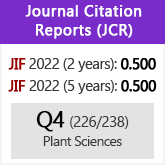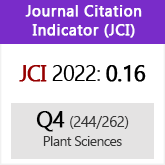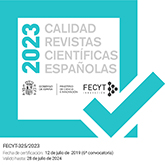Taxonomic revision of the genus Logfia (Asteraceae, Gnaphalieae) in the Mediterranean region
DOI:
https://doi.org/10.3989/ajbm.2330Keywords:
Filago group, chorology, Logfia clementei, L. gallica, L. heterantha, L. minima, nomenclature, taxonomy, typificationAbstract
The genus Logfia Cass. was described by Cassini in 1819 and has always been considered closely related to Filago L. The species of Logfia have been frequently included within Filago but, recently, based on morphological characters and DNA sequence analysis it has been demostrated that Logfia is more closely related to the American representatives of the tribe Filagininae than to the genus Filago and the idea that Filago and Logfia should be considered independent genera has been resurrected. In this work, the first complete taxonomic account for the western Mediterranean taxa belonging to Logfia is presented, based on the revision of more than 3400 sheets lodged at 32 herbaria. A detailed description of the genus and a key for the four species present in the study area are proposed. Descriptions of all species together with a complete nomenclatural treatment, as well as indications about habitat preferences, phenology, and geographic distribution are also provided. Additionally nine nomenclatural types are designated, among them, the lectotypes for the accepted names Logfia clementei (Willk.) Holub and Logfia minima (Sm.) Dumort. and the neotype of Logfia heterantha (Raf.) Holub.
Downloads
References
Anderberg, A.A. 1991. Taxonomy and phylogeny of the tribe Gnaphalieae (Asteraceae). Opera Botanica 104: 5-195.
Alavi, S.A. 1983. Evax, Filago & Logfia. In: Jafri, S.M.H. & El-Gadi, A. (eds.), Flora of Lybia 107: 33-57. Department of Botany, Al Faateh University, Tripoli.
Andrés-Sánchez, S., Galbany-Casals, M., Rico, E. & Martínez-Ortega, M.M. 2011. A nomenclatural treatment for Logfia Cass. and Filago L. (Asteraceae) as newly circumscribed: Typification of several names. Taxon 60: 572-576.
Andrés-Sánchez, S., Temsch, E., Rico, E. & Martínez-Ortega, M.M. 2013. Genome size in Filago L. (Asteraceae, Gnaphalieae) and related genera: Phylogenetic, evolutionary and ecological implications. Plant Systematics and Evolution 299: 331-345. http://dx.doi.org/10.1007/s00606-012-0724-3
Battandier, J.A. 1888. Evax, Filago & Micropus. In: Battandier, J.A. & Trabut, L. (eds.), Flore de l'Algérie Dicotylédones: 436-443. Alger typographie Adolphe Jourdan; librairie F. Savy, Argel, Paris.
Bentham, G. 1873. Tribus IV. Inuloideae. In: Bentham, G. & Hooker, J.D. (eds.), Genera Plantarum 2: 180-318. Lovell Reeve, London.
Bolòs, O. & Vigo, J. 1996. Filago. In: Flora dels Països Catalans 3: 721-731. Barcino, Barcelona.
Candolle, A.P. 1837. Filago. In: Prodromus systematis naturalis regni vegetabilis 6: 247-249. Paris.
Cassini, H. 1819. Examen analytique du genre Filago de Linné. Bulletin des Sciences par la Société Philomatique de Paris 1819: 141-144.
Castroviejo, S. (coord. gen.). 1986-2012. Flora iberica 1-8, 10-15, 17-18, 21. Real Jardín Botánico, CSIC, Madrid.
Cosson, E. & Germain E. 1843. Observations sur les genres Filago Tourn. et Logfia Cassini, et description d’une espèce nouvelle du genre Filago. Annales des Sciences Naturelles, ser. 2, 20: 283-292.
Devesa, J. 1987. Filago, Logfia, Evax & Bombycilaena. In: Valdés, B., Talavera, S. & Fernández-Galiano, E. (eds.), Flora Vascular de Andalucía Occidental 3: 24-31. Ketres, Barcelona.
Devesa, J. 2002. Bombycilaena, Evacidium, Evax, Filago & Logfia. In: Valdés, B., Rejdali, M., Achhal El Kadmiri, A., Jury, S.L. & Montserrat, J.M., Catalogue des plantes vasculaires du nord du Maroc, incluant del clés d’identification 2: 640-646. CSIC, Madrid.
Fernandes, A. & Queirós, M. 1971. Contribution á la connaissance cytotaxonomique des Spermatophyta du Portugal 2. Compositae. Boletim da Sociedade Broteriana, serie 2, 45: 92-93.
Fiori, A. & Paoletti, G. 1933. Iconographia Florae Italicae ossia Flora Italiana Illustrata. Tipografia Editrice Mariano Ricci, Firenze.
Galbany-Casals, M., Andrés-Sánchez, S., Garcia-Jacas, N., Susanna, A., Rico, E. & Martínez-Ortega, M.M. 2010. How many of Cassini anagrams should there be? Molecular systematics and phylogenetic relationships in the “Filago group” (Asteraceae, Gnaphalieae), with special focus on the genus Filago. Taxon 59: 1671-1689.
Greuter W. 2008. Evacidium & Filago. In: Greuter, W. & von Raab-Straube, E. Med-Checklist. A critical inventory of vascular plants of the circum-mediterranean countries. 2 Dicotyledones (Compositae): 218-224. OPTIMA Secretariat, Palermo; Med-Checklist Trust of OPTIMA, Genève; Euro+Med Plantbase Secretariat, Berlin.
Holub, J. 1975. Filago, Logfia, Evax & Bombycilaena. In: Davis, P.H. (ed.), Flora of Turkey and the East Aegean Islands 5: 101-114. Edinburgh University Press, Edinburgh.
Holub, J. 1976. Filago, Logfia, Evax & Bombycilaena. In: Tutin, T.G., Heywood, V.H., Burges, N.A., Moore, D.M., Valentine D.H., Walters, S.M. & Webb, D.A. (eds.), Flora europaea 4: 121-125. Cambridge University Press, Cambridge.
Linnaeus, C. 1753. Species Plantarum. Impensis Laurentii Salvii, Holmiae.
Maire, R. 1935. Contributions à l’étude de la flore de l’Afrique du Nord. Fascicule 23. Bulletin de la Société d'Histoire Naturelle de l'Afrique du Nord. Algiers 26: 184-234.
McNeill, J., Barrie, F.R., Burdet, H.M., Demoulin, V., Hawksworth, D.L., Marhold, K., Nicolson, D.H., Prado, J., Silva, P.C., Skog, J.E., Wieserma, J.H. & Turland, N.J. (eds.). 2006. International Code of Botanical Nomenclature (Vienna Code): Adopted by the Seventeenth International Botanical Congress Vienna, Austria, Juli 2005. Regnum Vegetabile 146. A.R.G. Gantner KG.
Pomel, A. 1874. Nouveaux Matériaux pour la Flore Atlantique. Librairie E. Savy, Paris & Juillet St.-Lager, Alger.
Reichenbach f., H.G. 1853. Evax, Gifola, Oglifa & Logfia. In: Reichenbach, L. & Reichenbach f., H.G. (eds.), Icones Florae Germanicae en Helveticae 16: 26-28. Sumptibus Ambrosii Abel, Lipsiae.
Smoljaninova, L. 1959. Filagininae. In: Schischkin, B.K. (ed.), Flora of the USSR 25: 281-303. Science Publishers, USA.
Stafleu, F.A. & Cowan, R.S. 1983. Taxonomic literature, vol. IV. Utrech, Netherlands.
Thiers, B. 2012. Index Herbariorum: A global directory of public herbaria and associated staff. New York Botanical Garden's Virtual Herbarium. http://sweetgum.nybg.org/ih/.
Valdés, B., Talavera, S. & Fernández-Galiano, E. (eds.). 1987. Flora Vascular de Andalucía Occidental 3. Ketres, Barcelona.
Wagenitz, G. 1968. Weitere Beiträge zur Kenntnis der Gattung Filago (Compositae-Inuleae). Willdenowia 5: 55-66.
Wagenitz, G. 1969. Abgrenzung und Gliederung der Gattung Filago L. s.l. (Compositae-Inuleae). Willdenowia 5: 395-444.
Wagenitz, G. 1980. Bombycilaena & Filago. In: Rechinger, K.H. (eds.), Flora des Iranischen Hochlandes und der Umrahmenden Gebirge 4: 11-27. Akademische Drucku. Verlagsanstalt. Graz.
Watanabe, K. 2012. Index to Chromosome numbers in Asteraceae. http:// www.lib.kobe-u.ac.jp/infolib/meta_pub/G0000003asteraceae_e
Willkomm, M. 1847. Spicilegium florae hispanicae. Botanische Zeitung. Berlin 5: 857-860.
Willkomm, M. 1870. Trib. VII. Gnaphalioideae. In: Willkomm, M. & Lange, J., Prodromus Florae Hispanicae 2: 51-67. E. Schweizerbart’sche Verlargsbuchhandlung, Stuttgart.
Downloads
Published
How to Cite
Issue
Section
License
Copyright (c) 2013 Consejo Superior de Investigaciones Científicas (CSIC)

This work is licensed under a Creative Commons Attribution 4.0 International License.
© CSIC. Manuscripts published in both the printed and online versions of this Journal are the property of Consejo Superior de Investigaciones Científicas, and quoting this source is a requirement for any partial or full reproduction.All contents of this electronic edition, except where otherwise noted, are distributed under a “Creative Commons Attribution 4.0 International” (CC BY 4.0) License. You may read here the basic information and the legal text of the license. The indication of the CC BY 4.0 License must be expressly stated in this way when necessary.
Self-archiving in repositories, personal webpages or similar, of any version other than the published by the Editor, is not allowed.

















